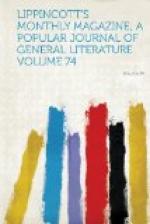Wanderings in Spain.
By Augustus J.C. Hare, author of
“Memorials of a Quiet
Life,” “Walks in Rome,” etc.
London:
Strahan & Co.; New York:
Dodd & Mead.
This companionable book tells you how to travel over the Spanish Peninsula by means of a slight knowledge of the Castilian tongue, a bold infidelity to Murray’s Guide, a cake of soap and some Liebig’s broth, and a habit of universal politeness. “Pardon me, my sister,” said the author to a beggar-woman at Barcelona: “does not your worship see that I am drawing?” “Ah, Dios!” she answered, “blind that I was! worm that I am! So your worship draws? And I—I too am a lover of the arts.” On the other hand, a stiff-necked Englishman traveling from Seville to Xeres sent his driver to dine in the kitchen of an inn on the road. The driver, who in his heart thought that he would have been doing great honor to a heretic by sitting at the same table with him, concealed his indignation at the time, but in the middle of the road, three or four leagues from Xeres, in a horrible desert full of bogs and brambles, pushed the Englishman out of the carriage, and cried out as he whipped on his horse, “My lord, you did not find me worthy to sit at your table; and I, Don Jose Balbino Bustamente y Orozco, find you too bad company to occupy a seat in my carriage. Good-night!” Another story, of time-honored repetition, is here restored to what may possibly have been its true parentage. A gypsy, on his knees to his priest, is tempted by the father’s snuffbox and steals it. “Father,” he says immediately, “I have one more confession: I accuse myself of stealing a snuffbox.” “Then, my son, you must certainly restore it.” “Will you have it yourself, my father?” “I? certainly not,” answered the confessor. “The fact is,” proceeded the gypsy, “that I have offered it to the owner, and he has refused it.” “Then you can keep it with a good conscience,” answered the father. Such are the glimpses of Spanish character. We could easily bear to have more of them; but the author, accompanied with ladies, and an antiquarian by habit and nature, gives more sketches of ruins, and of landscapes which are usually found “hideous,” than of the infinite whims of national manners. His contempt for Spanish landscape appears to us to amount to a disease: he scorns honest Murray for describing Valencia’s mud huts as “pearls set in emeralds,” and says that O’Shea’s eulogy of her as “the sultana of Mediterranean cities” is a glowing picture of what is dismal enough in reality. In fact, we are afraid that Mr. Hare has not exactly the artist’s eye, and cannot easily admire a scene in which he is not physically comfortable. But he has rich and heart-warm descriptions of the Alhambra, the Escorial, and the ruins of Poblet near Tarragona, where an order of patrician monks lived in incredible luxury until a time within present memory, when they were scattered by a tumult and their sculptured home crushed into dry and haggard ruin. This book cannot compare with his Walks in Rome, which was the careful record of a familiar and a resident; but it is the result of a very lively curiosity and the record of a mind evidently stored with history and romance. Excepting Colonel Hay’s inimitable Castilian Days, it is the best recent book about the country which it skims over.




